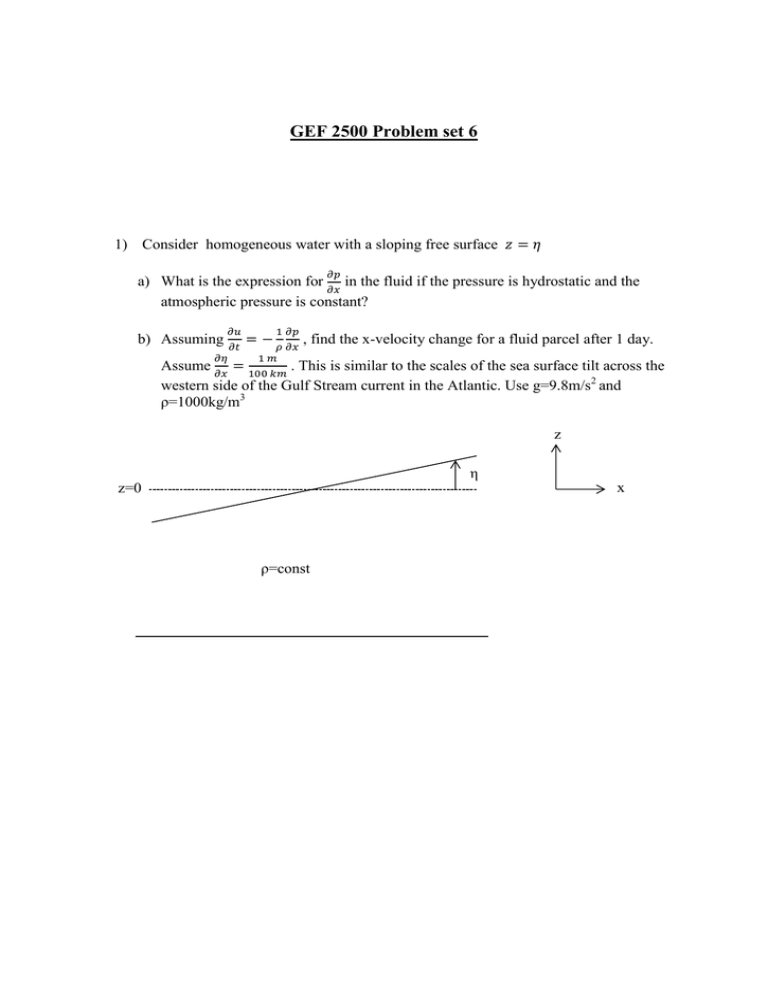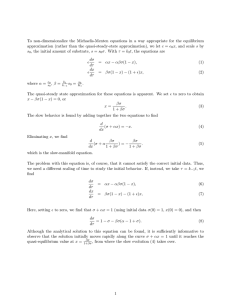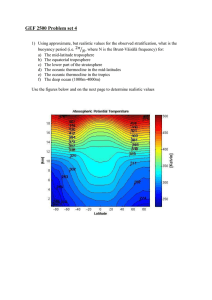GEF 2500 Problem set 6
advertisement

GEF 2500 Problem set 6 1) Consider homogeneous water with a sloping free surface a) What is the expression for in the fluid if the pressure is hydrostatic and the atmospheric pressure is constant? b) Assuming , find the x-velocity change for a fluid parcel after 1 day. Assume . This is similar to the scales of the sea surface tilt across the western side of the Gulf Stream current in the Atlantic. Use g=9.8m/s2 and ρ=1000kg/m3 z η x z=0 ρ=const 2) Linear shallow water equations η z=0 z H z=-H x Consider a constant density, inviscid flow in the (x,z) plane. The linearized equations for surface gravity waves can be written as ( ) ( ) ( ( ) ) ( ) ( ) ( ) The equations are phrased in terms of the perturbation pressure ( ) For “shallow water waves”, the characteristic horizontal length scale L is long compared to the fluid depth, so . In this problem, we conduct a scale analysis to get the case without assuming a sinusoidal structure. We let [] denote the characteristic length scale of, so [ ] and [ ] . Assume [ ] (to satisfy the linearity assumption) and [ ] (which is unknown) From the equations listed above, argue that: a) [ ] b) [ ] c) [ ] [ ] d) And show that [ ] [ ] [ ] . e) Applying (5), conclude that within a small relative error ( ), ( ) ( ) ( ) f) Applying the result of e) to (1), deduce that ( ) Note that the right hand side is z-independent, so the left hand side, and hence u, may also be assumed to be z-independent. g) Deduce that ( ) ( ) ( ) Equations (6) and (7) constitute the linear shallow water equations (LWE) for ( ) and ( ). These equations are just like those for linear 1D sound waves except with and h) From (7), deduce that the timescale i) A rightward-propagating sinusoidal linear shallow water wave propagates into a part of the fluid layer that is at rest. Consider a material column of fluid of small width extending from the bottom of the fluid layer at to its top (initially at z=0). Sketch the shape and horizontal displacement of the column as it is deformed during the four phases of a wave (trough, upward velocity maximum, crest, downward velocity maximum). Pay attention to keeping the changes in the column width consistent with the changes in height. A qualitative correct plot is fine; no math required here. 3) Another take at the continuity equation a) Derive the conservation of mass equation (1.4.8) in the compendium. b) If the density is constant everywhere, it is trivial to show that the continuity equation may be written as ⃗ . In the atmosphere, this approximation is not necessarily fulfilled, as air is compressible. However we will now look at an example where the continuity equation still applies. Consider large scale atmospheric motion. Typical horizontal length scale L=1000 km, vertical length scale H=10 km and horizontal velocities U=10 m/s. Typical time scale is 1 ( ) day. The density is separated as ̂( ), where ( ) ̂ . We assume that | | | | Use conservation of mass to show that under these circumstances, the continuity equation ⃗ is a valid approximation, even though the density is not constant. c) Use scale analysis to show that in the case described above, the hydrostatic approximation is a valid one. Insert realistic values (scale values) into the continuity equation to obtain a characteristic value for the vertical velocity. d) Consider the vertical component of Navier Stokes equation, i.e. eqn. 1.6.5 and 1.6.8c in the compendium. Insert realistic values (scale values) and show that the dominate balance indeed is the hydrostatic balance. e) Consider a convective cumulus cloud. The vertical velocities are in the range of 1025m/s. Use typical values of U~W~20m/s, L~1km, H~500m and T~100sek. Would you assume hydrostatic conditions in such a system?

